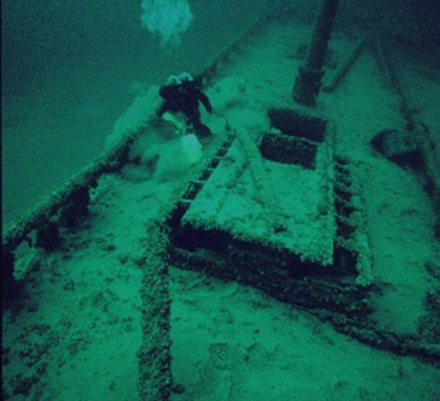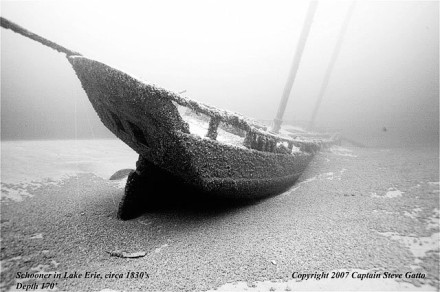History
History of the wrecksite
The Dunkirk Schooner wrecksite -situated at 32 kilometers off the Dunkirk, New York, coast in Lake Eerie - was first located by visual observation in the early 1990's, by employees of Northeast Research, LLC, a Massachusetts company involved in locating and salvaging shipwrecks. It wasn't until 2004 that a team was assembled to excavate and document the wrecksite. It was at this point that Northeast Research applied for custodianship of the wreck site, which was granted, and archaeological research was begun.

The wreck site was considered to be 'remarkably pristine and intact' according to a representative of Northeast Research, which was attributed in part to the cold temperatures of its environment, as the water has not been reported to rise above three degrees Celsius. The wreck is of a two-masted schooner in very good shape, with its masts still standing.
Northeast had filed for a museum permit and hoped to work with the state of New York to raise the shipwreck and have it exhibited in a Buffalo museum. The state initially granted Northeast a permit to excavate at the wrecksite to determine the identity of the ship.
Divers did not find anything indicating the name of the ship, but they did uncover a range of artifacts indicative of the daily life on board, such as ceramic wares, watches, compasses, lamps, furniture and coins dating from 1797 to 1834. Human bones were also found, which, through DNA analysis, were determined to likely be of people of white descent. This find also indicates that (part of ) the crew went down with the ship.
Legal battle
The identity of the wreck was later legally contested by the State of New York in a legal battle regarding ownership of the wreck. The state intervened legally in 2004, an event which coincided with the conclusion of Northeast Research's archaeological research project. This intervention was the beginning of a nine year legal battle over the fate of the wreck site, that had become known as the Dunkirk Schooner.
The legal dispute hinged on whether the wrecksite was that of a legally abandoned shipwreck. The identity of the ship was contested as a factor in proving whether the ship could indeed be declared abandoned. According to the Abandoned Shipwreck Act of 1987, any wreck in the US declared legally abandoned (where the owner(s) or descendants relinquished valid claims of ownership) would revert to ownership by the government, in this case the state of New York.
Two possible identities of the ship were presented by Northeast Research and the representatives of New York. Northeast Research maintained that the wreck was that of the Caledonia, a ship involved in the War of 1812 and later the Underground Railroad (a system of smuggling African Americans to freedom in Canada). Northeast Research insisted that the final owners of the ship did not abandon the wreck, and that contemporary descendants had not relinquished their claims either.
According to research by the Center for Maritime & Underwater Research Management (CMURM), the Caledonia was built in 1799 by the British in Windsor, Canada as a merchant vessel and was later armed with cannons after the War of 1812 broke out. The ship was subsequently captured by the Americans on the Niagara River and converted into an warship. It was instrumental in a key victory in the 1813 Battle of Lake Erie.
According to newspaper accounts and a bill of sale, the ship was sold in 1815 to John Dickson and Rufus S. Reid, who rebuilt it and renamed it the General Wayne. CMURM stated that the schooner could be the General Wayne or one of three other ships, but did not give a definitive answer to its identity.
Northeast presented as evidence a report from a maritime archeologist, James Sinclair, that concluded the shipwreck was the General Wayne based on physical evidence including measurements and its distinctive bow shaped like a fiddlehead'.
Arthur B. Cohn, executive director of the Lake Champlain Maritime Museum, was appointed as the expert witness of the state. He concluded the shipwreck was not the General Wayne, but an unidentified merchant vessel built shortly before 1829 which had sunk between 1834 and 1844.
Thus, the legal battle generated research into the identity of the ship, but because both sides were biased, it is hard to judge the validity of the results.
The court concluded that the passage of over 150 years since the vessel sank and the fact that no one tried to find or salvage it showed it was abandoned, thus ruling in favor of the state. A advisory panel that reviewed the evidence found it most likely that the ship was the General Wayne, still supported the claim of abandonment by the state since there had been no efforts to find it for over 150 years.
Northeast claims the state’s expert witnesses never saw the shipwreck, photographs of it or dove on it. They stated they spent $1.7 million to find the shipwreck and that the company is entitled to the shipwreck and the value of its cargo. They also maintain that the ship is the Caledonia and, through the process of elimination, can be no other.
Patrick Clyne, part owner of Northeast, said the schooner is of high historical importance, not only for its part in the War of 1812, but that after the war, it was used by Dickson and Reid to smuggle escaped enslaved people into Canada.
He believes that is why there is no name plate, because they removed it during trips to Canada because helping enslaved people to freedom was illegal.
Much of the information presented here is from the court documents and the expert witness statement of Cohn.
Description
The ship had two masts, which are still standing.

| Length | 78 ¾ feet (24 m) |
|---|---|
| Width | 19 feet (5.8 m) |
Status
In 2009 the wreck was listed in the National Register of Historic Places.
References
- Denise M. Champagne/The Daily Record.
Second Circuit: Lake Erie shipwreck belongs to the state.